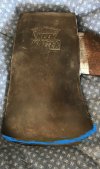A friend gave me this big (4 1/2#) Keen Kutter Ct. pattern(?) and I don't know how to proceed. It was painted silver and I used a wire wheel to remove most of it. As you can see there is a major bite out of the heel. Should I just sharpen it and ignore or try to reshape the bit a bit?
Also the handle tho lovely seems a tad short and slender at 27" for such a large axe. What do you folks think? The handle seems to have a marking on it which reads
-----Mfg. Co.
Gold Coin
Is that a known handle supplier?
Any advice or opinions sought...




Hey! It looks like I'm getting the "hang" of posting pics. Look out forum!
Also the handle tho lovely seems a tad short and slender at 27" for such a large axe. What do you folks think? The handle seems to have a marking on it which reads
-----Mfg. Co.
Gold Coin
Is that a known handle supplier?
Any advice or opinions sought...




Hey! It looks like I'm getting the "hang" of posting pics. Look out forum!







 P1040278
P1040278 P1040280
P1040280